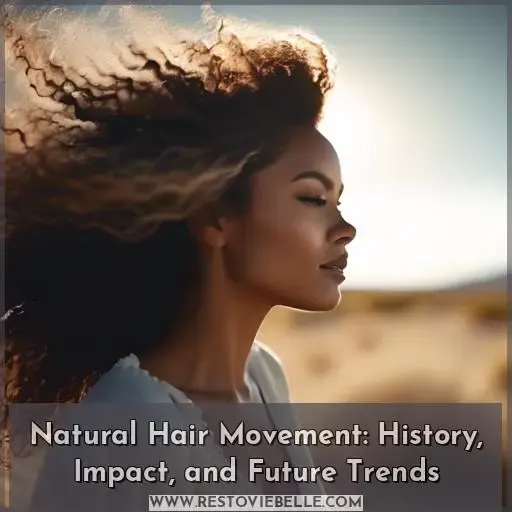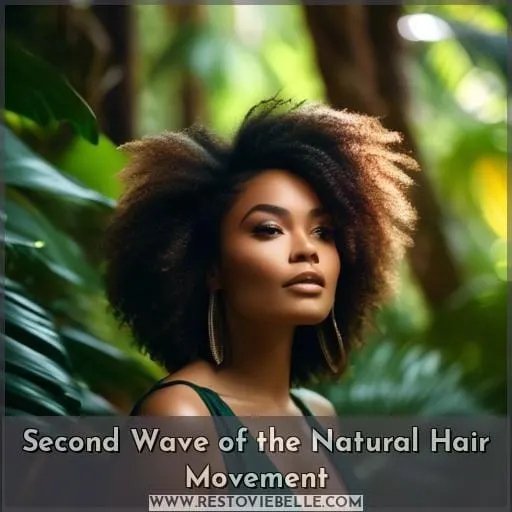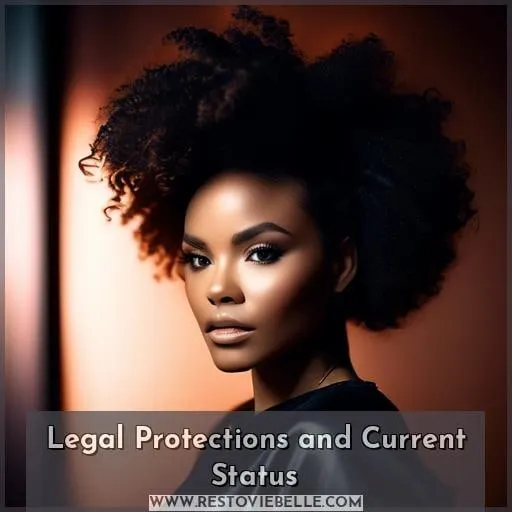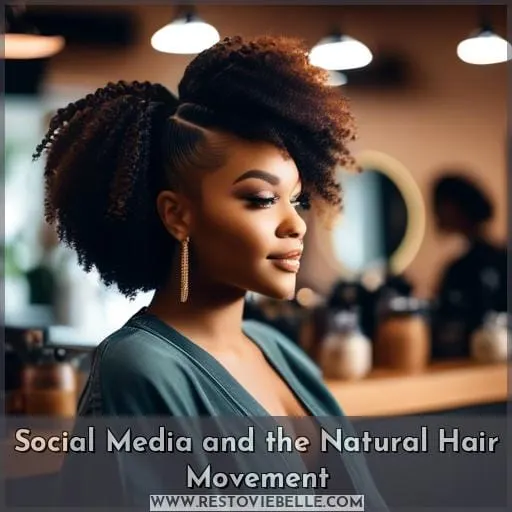This site is supported by our readers. We may earn a commission, at no cost to you, if you purchase through links.

From its roots in the fight against anti-Black hair sentiment to its blossoming across social media platforms, this movement has not only reshaped beauty standards but also sparked legal battles for equality.
As you delve into the past, present, and future of embracing natural, afro-textured hair, you’ll discover a world where each curl and coil tells a story of liberation, belonging, and understanding.
Table Of Contents
- Key Takeaways
- Historical Context of Anti-Black Hair Sentiment
- First Wave of the Natural Hair Movement
- Second Wave of the Natural Hair Movement
- Natural Hair Movement Today
- Legal Protections and Current Status
- History of Natural Hair
- Social Media and the Natural Hair Movement
- Bloggers and the Black Beauty Space
- The Business of Natural Hair
- The Future of the Natural Hair Movement
- Frequently Asked Questions (FAQs)
- How do cultural perceptions of natural hair vary globally, and how have these perceptions influenced the natural hair movement?
- What role do gender and sexuality play in the natural hair movement, considering the experiences of non-binary and transgender individuals within this community?
- How have educational institutions responded to the natural hair movement, particularly in terms of dress codes and policies affecting students with natural hairstyles?
- What are the environmental impacts of the natural hair movement, especially regarding the production and disposal of natural hair care products?
- How does the natural hair movement intersect with issues of mental health and body image, especially among young Black individuals navigating their identity?
- Conclusion
Key Takeaways
The natural hair movement is deeply intertwined with Black identity, empowerment, and resistance against Eurocentric beauty standards, evolving from historical contexts of oppression to a contemporary celebration of natural hair textures.
Social media and online communities have played a pivotal role in the resurgence and spread of the natural hair movement, offering platforms for sharing experiences, advice, and fostering a sense of community among individuals embracing their natural hair.
Legal battles and advocacy efforts, such as the CROWN Act, highlight the ongoing struggle against natural hair discrimination in the workplace and society, underscoring the movement’s role in challenging systemic racism and promoting legal protections for Black individuals.
Despite significant progress, challenges such as cultural appropriation, texturism, and the need for greater inclusivity within the natural hair community persist, pointing to the complex and evolving nature of the movement and its future directions.
Historical Context of Anti-Black Hair Sentiment
You’ve likely felt the sting of anti-black hair sentiment, a legacy of oppression that’s woven into the fabric of American history. Enslaved Africans, stripped of autonomy, once mimicked their enslavers’ hairstyles, seeking a semblance of higher status within a rigid hierarchy.
Fast forward to 1786, and you’ll find the Tignon Laws in Louisiana, a blatant attempt to police black women’s bodies, mandating that free Creole women cover their hair. Yet, these women subverted this oppression, transforming the tignon into a symbol of resistance and elegance.
As the Civil Rights Act of 1964 aimed to dismantle employment discrimination, the Black Is Beautiful movement and figures like Marcus Garvey championed the natural beauty of black hair, encouraging a return to natural kinks and curls.
Despite this, Eurocentric beauty standards persisted, leading to court cases like the one against American Airlines in 1981, which controversially ruled that braids weren’t a protected racial characteristic.
This history isn’t just about hair; it’s a fight against white supremacy and a struggle for the right to self-expression and cultural identity.
First Wave of the Natural Hair Movement
During the first wave of the natural hair movement, you’re stepping into a period of profound cultural and political awakening. It’s the 1960s, and the air is charged with the spirit of the Civil Rights movement.
This era isn’t just about fighting for equality in the eyes of the law; it’s about reclaiming and celebrating Black identity in its most natural form. The Black Is Beautiful movement is at the forefront, challenging Eurocentric standards of beauty and encouraging Black men and women to embrace their natural hair textures.
Icons like Angela Davis become symbols of this movement, her afro not just a style but a statement of power, resistance, and solidarity.
Amidst this backdrop, the Civil Rights Act of 1964 emerges as a beacon of hope, banning employment discrimination and laying the groundwork for a society that values diversity and inclusion. Yet, despite this legal protection, Black individuals continue to navigate a world where their natural hair is often seen as unprofessional or undesirable, a sentiment deeply rooted in centuries of racism and discrimination.
- The movement was a bold declaration that Black features are beautiful and worthy of celebration, not alteration to fit a Eurocentric ideal.
- It was a call to action for Black individuals to embrace their natural kinks, curls, and afros, and to reject the notion that their hair needed to be relaxed or straightened to be considered attractive or professional.
- This era marked the beginning of a journey towards self-acceptance and empowerment for many Black individuals, challenging societal norms and inspiring future generations to proudly wear their natural hair.
This first wave of the natural hair movement wasn’t just about hair; it was a powerful expression of Black pride and a crucial part of the broader struggle for civil rights and social justice.
Second Wave of the Natural Hair Movement
As you’ve journeyed through the history of the natural hair movement, you’ve seen how the first wave laid the groundwork for a profound cultural shift. Now, let’s dive into the second wave, a period marked by its fight against natural hair bias and workplace discrimination.
This era wasn’t just about hair; it was a broader battle for social justice and cultural identity, deeply intertwined with the legal challenges that black individuals faced simply for embracing their natural hair.
The second wave saw the rise of hair influencers on social media, who played a pivotal role in reshaping perceptions of beauty. Platforms like YouTube became arenas where individuals could share their hair care routines, offer support, and celebrate the cultural significance of natural hairstyles.
This social media influence helped to foster a community that wasn’t only about hair but also about reclaiming cultural identity and pushing back against Eurocentric beauty standards.
Legal battles, such as Jenkins v. Blue Cross Mutual Hospital Insurance, highlighted the ongoing struggle against hair discrimination in the workplace. These cases underscored the need for legal protections for natural hair, as biases continued to manifest in professional settings.
Despite these challenges, the movement’s momentum was undeniable, driven by a collective desire for liberation and belonging.
The second wave of the natural hair movement was a testament to the power of community, social media, and legal advocacy in challenging societal norms and advocating for the right to embrace one’s natural hair.
It was a period of significant growth, understanding, and solidarity, laying the foundation for the ongoing fight for acceptance and equality.
Natural Hair Movement Today
As the second wave of the natural hair movement paved the way for greater acceptance and legal victories, the landscape of Black hair has continued to evolve with the times. Today, you’re part of a global community where social media impact and industry transformation have redefined what it means to wear your hair naturally.
Social Media Impact: Platforms like YouTube and Instagram have become the epicenter of the natural hair movement, offering a space for you to share experiences, tips, and support. The visibility of natural hairstyles has skyrocketed, thanks to the countless posts and tutorials that celebrate the diversity of Black hair textures.
Industry Transformation: The beauty industry has witnessed a seismic shift, with a significant decline in perm relaxer sales and a corresponding rise in products catering to natural hair. This change not only speaks to changing consumer preferences but also to a broader embrace of natural beauty standards.
Representation Matters: High-profile celebrities and influencers flaunting their natural curls and coils on red carpets and social media have bolstered the movement. This visibility has been crucial in normalizing natural hair and inspiring you to wear your hair with pride.
Legal Protections and Future Trends: With legal protections like the CROWN Act and guidance from entities like the New York City Commission on Human Rights, there’s a growing recognition of the right to wear natural hair without fear of discrimination. These developments hint at future trends where natural hair isn’t just a style choice but a celebrated aspect of cultural identity.
Legal Protections and Current Status
You’re navigating a landscape where race discrimination and workplace bias against natural hair are still pressing issues. Despite the EEOC’s guidelines that protect against discrimination based on physical characteristics associated with race, including hair, the legal landscape remains complex.
The EEOC maintains that employers can’t discriminate against hairstyles like afros, as they’re a natural expression of Black identity, but judicial interpretations vary.
In some cases, courts have upheld anti-discrimination laws, as seen in Jenkins v. Blue Cross Mutual Hospital Insurance, where the court recognized afros under Title VII of the Civil Rights Act. However, the Eleventh Circuit’s decision in Jones v. Catastrophe Management Solutions, which ruled that locs aren’t a protected racial characteristic, shows the ongoing challenges.
Local governments are stepping up, with the New York City Commission on Human Rights committing to protect the right to wear natural hairstyles. California has also passed legislation to ban discrimination against natural black hairstyles in the workplace.
These efforts are part of a broader movement to combat hair discrimination, with advocates like Lorraine Massey and Ouidad championing the beauty of natural curls and pushing back against Eurocentric beauty standards.
The CROWN Act, which prohibits race-based hair discrimination, represents a significant step forward, although it’s not yet federal law. As you continue to assert your right to embrace your natural hair, remember that the fight for legal protections is ongoing, and each victory is a step toward a more inclusive society where your hair is a celebrated aspect of your identity.
History of Natural Hair
As we transition from discussing the legal protections and current status of natural hair, it’s crucial to delve into the rich tapestry of its history. The evolution of Black hair is a narrative of resilience, creativity, and the unyielding spirit of the Black community.
Tignon Laws and Resistance: In 1786, the Tignon Laws mandated that Creole women cover their hair to mark their status. Far from being suppressed, these women turned these restrictions into fashion statements, adorning their wraps with jewels and ribbons, showcasing the enduring resilience and creativity of Black women.
Chemical Relaxers and the Push for Conformity: In the early 20th century, inventors like Garrett Augustus Morgan introduced chemical relaxers. This innovation was a double-edged sword; while it offered new styling options, it also underscored the pressure to conform to Eurocentric beauty standards, highlighting the complex relationship between Black hair, identity, and societal acceptance.
Civil Rights Movement and the Afro: The 1960s Civil Rights movement heralded a significant shift. Icons like Angela Davis wore Afros as symbols of pride, resistance, and solidarity. This era marked a pivotal moment in the history of natural hair, as it became intertwined with the broader struggle for equality and justice.
These moments aren’t just historical footnotes; they’re chapters in the ongoing story of Black hair evolution. They reflect a journey of overcoming adversity, embracing identity, and challenging societal norms.
As we look to the future, the legacy of these milestones continues to inspire and shape the natural hair movement, underscoring the importance of hair as a powerful symbol of Black heritage, beauty, and empowerment.
Social Media and the Natural Hair Movement
As you navigate the digital world, you’ll find that social media influencers have become pivotal in shaping the natural hair movement. Online communities on platforms like YouTube and Instagram have fostered a space where hair tutorials and product reviews thrive, offering natural hair inspiration to countless individuals.
Hair vloggers have taken center stage, sharing their personal hair styling journeys, which often include discussions about hair damage and the broader implications of hair fashion.
These influencers are more than just content creators; they’re educators and advocates for embracing natural hair. Their impact is evident in the way hair products are marketed and developed, with many brands now seeking the endorsement and input of these trusted voices within the community.
Whether you’re looking for advice on the best hair care routines or seeking solidarity in the challenges of maintaining natural hair, these social media platforms offer a wealth of resources and support.
The natural hair movement, amplified by these influencers, continues to challenge conventional beauty standards and encourages a celebration of individuality and cultural heritage.
Bloggers and the Black Beauty Space
You’ve likely noticed the rise of Black beauty bloggers and natural hair influencers, reshaping the landscape of representation in media. These trailblazers are carving out spaces in online hair communities, offering a handbook of sorts for those navigating the world of Black hair culture.
They’re not just setting hair trends; they’re dismantling long-standing barriers.
Take Patrice Yursik of Afrobella, who started her blog in 2006 to spotlight natural hair products and icons. Her platform became a beacon for many, inspiring her to dedicate herself fully to this cause.
Similarly, Whitney White, better known as Naptural85 on YouTube, has been a guiding light for those embracing their spirals and kinks.
These influencers have transformed hair salons into places of empowerment, where Black hair isn’t just styled but celebrated. Their work has been instrumental in the business of natural hair, pushing brands to expand their offerings and cater to a market that was once overlooked.
As you scroll through your social media feeds, you’re witnessing a powerful narrative unfold—one where Black hair is revered, not just tolerated. It’s a movement that’s here to stay, driven by a community’s desire for liberation and belonging.
The Business of Natural Hair
The natural hair movement has significantly influenced the beauty industry, birthing a billion-dollar segment dedicated to natural hair products. Black-owned brands have been at the forefront, innovating and catering to a market that was once overlooked.
These pioneers haven’t only introduced a range of products for diverse hair textures but also challenged legacy brands to pivot towards more inclusive offerings. Your support for these brands goes beyond just buying products; it’s a celebration of representation in media and an acknowledgment of the ‘curl power’ that these businesses embody.
As you choose from a plethora of options, remember that each purchase is a step towards a more inclusive beauty industry where every curl and coil is valued and catered to.
The Future of the Natural Hair Movement
As you look ahead, the future of the natural hair movement is ripe with potential for greater inclusivity and legal protection. The CROWN Act, already passed in several states, is a beacon of hope, aiming to outlaw race-based hair discrimination in workplaces and schools.
Yet, the journey is far from over. Cultural appropriation remains a contentious issue, as non-Black individuals adopt Black hairstyles without facing the same discrimination. Texturism, too, continues to challenge the movement, with tighter curls often marginalized even within the Black community.
Intersectionality is key to understanding these overlapping forms of discrimination, as they don’t exist in isolation. Representation in media and society is crucial; it’s vital for young Black individuals to see themselves reflected in a positive light, normalizing and celebrating the diversity of Black hair.
The natural hair movement isn’t just about hair; it’s a fight for identity, respect, and legal recognition. Embrace your curls, coils, and kinks; they’re a crown to be worn with pride and defiance in the face of societal norms.
Frequently Asked Questions (FAQs)
How do cultural perceptions of natural hair vary globally, and how have these perceptions influenced the natural hair movement?
Cultural perceptions of natural hair vary globally, impacting the natural hair movement’s evolution.
Societal norms and racial discrimination historically influenced these views, leading to a resurgence in embracing natural textures.
This shift challenges Eurocentric beauty standards, fostering self-acceptance and cultural pride among Black communities worldwide.
What role do gender and sexuality play in the natural hair movement, considering the experiences of non-binary and transgender individuals within this community?
In the natural hair movement, gender and sexuality are pivotal, especially for non-binary and transgender individuals. Their hair journeys often intersect with their exploration and expression of identity, offering a unique space for self-discovery and affirmation.
For many, embracing natural hair becomes a powerful statement of authenticity and resistance against conventional gender norms, fostering a sense of community and belonging amidst diverse expressions of gender and sexuality.
How have educational institutions responded to the natural hair movement, particularly in terms of dress codes and policies affecting students with natural hairstyles?
Echoing the spirit of the CROWN Act, educational institutions are increasingly revising dress codes to welcome natural hairstyles. This recognition acknowledges the cultural significance and rejects biases that have long marginalized students for their authentic selves.
What are the environmental impacts of the natural hair movement, especially regarding the production and disposal of natural hair care products?
You’ll find that the natural hair movement’s environmental impact is multifaceted, involving both product ingredients and packaging.
The production of hair care products often uses non-renewable resources and generates pollution, while the disposal of plastic containers contributes to landfill waste and ocean pollution.
Chemicals in these products can harm aquatic life and ecosystems when washed down the drain.
To mitigate these effects, consider sustainable brands and proper recycling.
How does the natural hair movement intersect with issues of mental health and body image, especially among young Black individuals navigating their identity?
Navigating the natural hair movement is akin to embarking on a deeply personal odyssey for young Black individuals, where each curl and kink maps out a journey of self-discovery and acceptance.
Amidst this exploration, the terrain of mental health and body image emerges as both a challenge and a sanctuary. The movement, at its core, isn’t just about rejecting Eurocentric beauty standards but also about weaving a tapestry of self-love and resilience.
For many, this journey towards embracing one’s natural hair texture becomes intertwined with battles against internalized racism and societal pressures, often leading to moments of vulnerability and strength.
The emotional labor involved in this process can significantly impact one’s mental health, as the act of reclaiming one’s natural hair often necessitates confronting deep-seated insecurities and societal biases.
However, it also offers a unique opportunity for empowerment and healing, as individuals learn to see their natural beauty through a lens unclouded by prejudice. In this way, the natural hair movement serves as both a mirror reflecting the struggles faced by young Black individuals in navigating their identity and a beacon guiding them towards a more accepting and inclusive understanding of beauty.
Conclusion
As the sun sets on our exploration of the natural hair movement, it’s clear that this journey is far from over. Like the resilient strands of afro-textured hair, the movement has twisted and turned through history, growing stronger and more vibrant with each coil.
You’ve seen how it’s not just about hair; it’s a profound statement of identity, pride, and resistance against a world that once demanded conformity. The natural hair movement has blossomed into a global tapestry of empowerment, weaving together stories of liberation and belonging.
With every curl and kink, it challenges outdated norms and carves out spaces for future generations to thrive in their authentic beauty. As you move forward, remember that each strand tells a story, and together, they’re crafting a future where natural hair isn’t just accepted but celebrated.
















